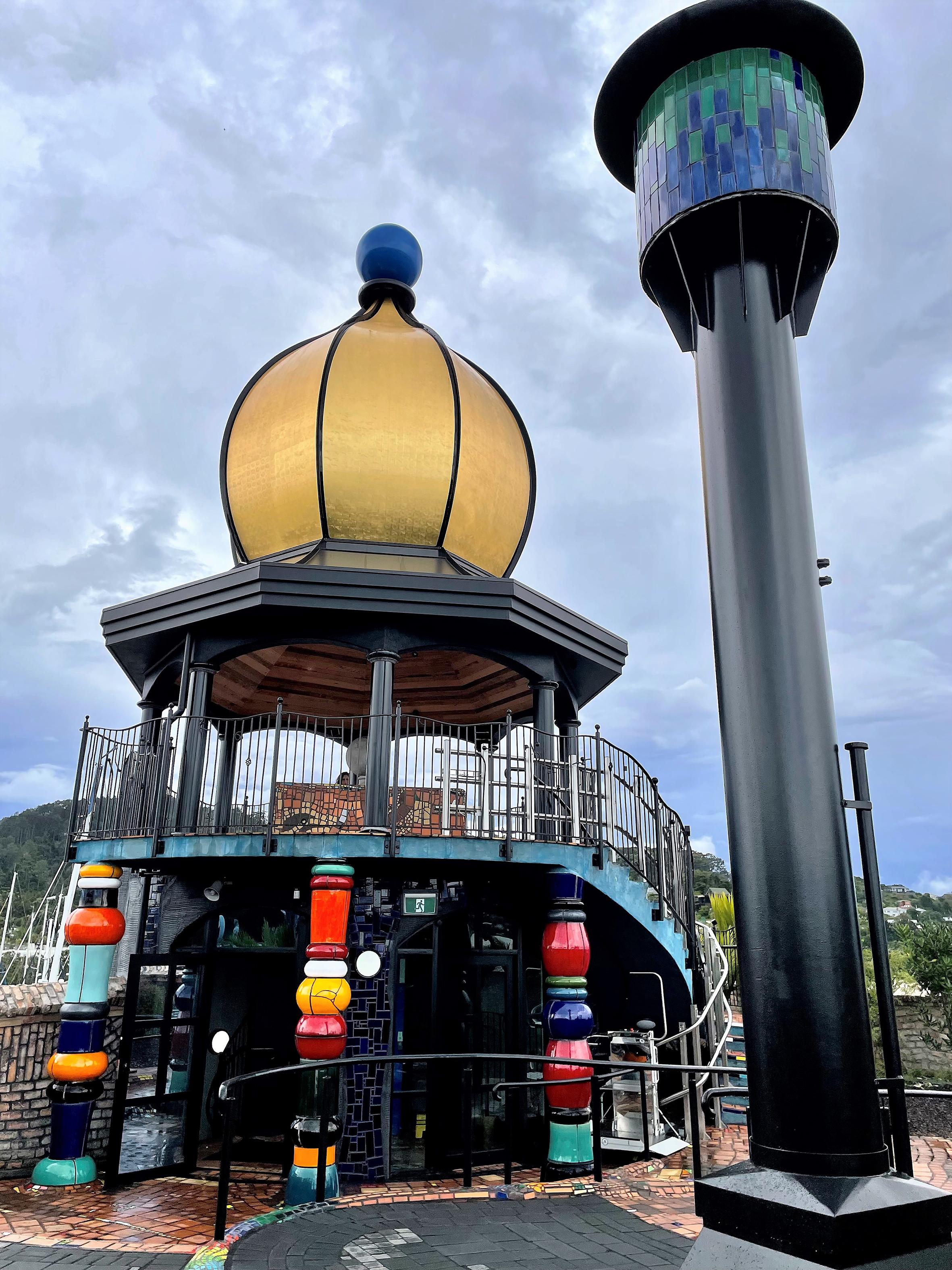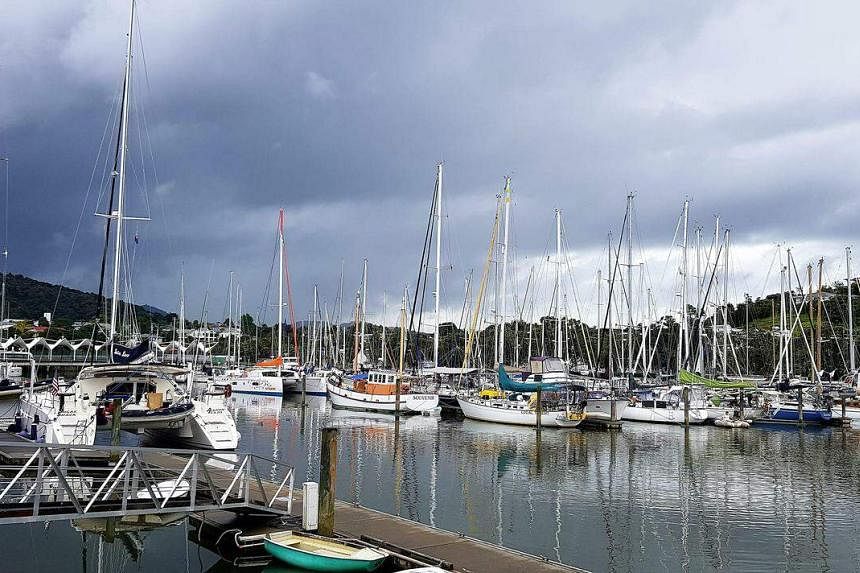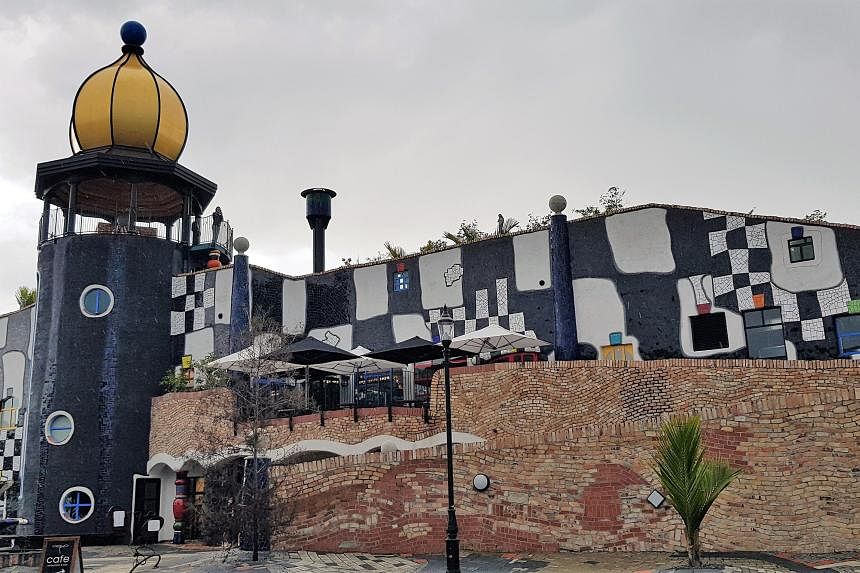NEW ZEALAND – Usually, one does not put toilets on a travel itinerary. When you have to go, you go.
But the toilets in little Kawakawa are not ordinary ones. Merrily decorated with ceramic pillars and vivid mosaics, they were designed and built by a world-famous artist.
Before the pandemic, they drew some 250,000 visitors each year and put a small New Zealand town on the tourist map.
I had liked Austrian artist and architect Friedensreich Hundertwasser even before I heard about his connection to New Zealand.
In Vienna, admirers look for Hundertwasser buildings – always colourful and irregularly shaped, with plants sprouting from all corners. He designed residential buildings, kindergartens and schools, market halls and even an incineration plant in Osaka.
Yet, despite his European roots, Hundertwasser seemed destined for New Zealand.
April 2023 marks the 50th anniversary of his first visit, when he spent months driving around the country and falling in love with its beauty.

During his visits, he settled in an old farmhouse in the Kaurinui Valley near Kawakawa, Northland. He planted trees and turned an old cowshed into a grass-roofed building with translucent bottles embedded into walls.
He had an outdoor bathtub and used what he called a humus toilet, believing that human waste’s transformation into compost is a way of giving back to nature.
Hundertwasser was concerned about recycling and sustainability long before these became buzzwords. All through his life, peace with nature and the protection of the environment were recurrent themes.
In 2000, he died of a heart attack aboard the Queen Elizabeth II on a trip back to Europe. According to his wishes, he was buried on his land in New Zealand.

Two decades later, New Zealand has reclaimed the Austrian artist. Friends in Kawakawa banded to form the Hundertwasser Memorial Park Charitable Trust and built a memorial.
Opened on Oct 9, 2020, by former prime minister Jacinda Ardern, the memorial includes two heart-shaped buildings.
The first is the Hundertwasser Centre, where posters and write-ups tell the artist’s story. A documentary features Kawakawa residents speaking about their friend and neighbour, “Friedrich”.
The second building houses the new public library. The complex is surrounded by a small park where the grass is regularly mowed by the members of the trust themselves.

Some 50km or a 45-minute drive away is the town of Whangarei. In February 2022, a new Hundertwasser Art Centre opened. It has a rooftop garden, colourful outdoor tiles and a golden-onion dome, another Hundertwasser architectural motif.
The building is based on a draft by Hundertwasser for a community art gallery. This realisation came only after years of standstills and political disputes, and the centre would not have been possible without the support of the Hundertwasser Museum in Vienna.
Its beautiful contents, including original artwork and tapestries, show not only the artist’s commitment to environmentalism, but also a successful career as he exhibited in the art capitals of the world.

The art centre is a new addition to the quay area of Whangarei – which, with quality souvenir shops, fine delicatessens and restaurants, makes Whangarei a more glamorous and stay-worthy stop.
But I am glad to have visited Kawakawa first. Although Hundertwasser never stopped travelling, he always returned to Kawakawa.
In the late 1990s, when the town needed new toilets, he was happy to oblige. He not only designed but also helped on site, chastising workmen for making the lines too straight.
“It must be like the way young children are learning to ride their bikes,” he said. This was related to me by Kawakawa local Shirley Bradshaw, who knew Hundertwasser personally. A member of the trust, she was also the art centre’s cashier on the day I visited.

Too shy to attend the official opening ceremony in December 1999, Hundertwasser had his speech read out: “I am happy I could do something for Kawakawa. It is only a toilet, but it should show that even small things can bring beauty into our life. We live only once and money-making is not all. It is harmony with beauty and harmony with nature which makes us feel really good.”
He added: “I am sorry I am not here today, but I hate being the centre of interest. This is why I live in New Zealand. What I did must speak for itself and not my person.”
Seeing that handwritten pencilled note in Kawakawa moved me. After that, of course, I used the toilets.
Getting there
Fly to Auckland. Kawakawa and Whangarei are popular stops for tour operators offering trips to Northland, the northernmost part of North Island in New Zealand.
Such tourist trips usually include Cape Reinga and the pretty area called Bay of Islands, which is about a three-hour drive from Auckland. Alternatively, hire a car and drive around.
What to do

Both Whangarei and Kawakawa are interesting stops for those driving from Auckland to Cape Reinga or Bay of Islands.
Stop at Pahia, a popular beach resort, to go cycling, diving, helicoptering, sailing, swimming, surfing, skydiving or paragliding. Visit the historic Waitangi Treaty Grounds or take the ferry across the bay to Russell, the site of the first European settlement in New Zealand, and visit the cafes and shops.
Kawakawa has a historic railway track going through the town centre and a vintage-looking cafe at the station.
In Whangarei, visit the nearby Whangarei Falls or Mount Parahaki, the site of a former Maori village. The area near the Hundertwasser Art Centre is also charmingly landscaped and lined with art murals, shops, restaurants and galleries.
Quest for art in Europe
Artists are famously influenced by their environment. A visit to their homes, towns or regions can enhance one’s understanding of their art.
If you are planning a trip to Europe, consider these places to catch a whiff of the artists’ personalities and sources of inspiration.
> In the Netherlands, visit the city of Delft. The cobbled streets, narrow houses, alleys and courtyards do not look too different from the way they are depicted in the paintings of Dutch artist and Old Master Johannes Vermeer. You can visit the Royal Delft factory, which celebrates its 370th anniversary this year, and see the pottery featured in old Dutch paintings.
> In Germany, I like the short-lived Expressionist Der Blaue Reiter (The Blue Rider) movement founded in Munich. The most famous artist is probably Russia-born Wassily Kandinsky, but I am a fan of his companion, German painter Gabriele Muenter. My visit to their house in Murnau, a lovely village in the Bavarian foothills, coincided with that of a group of art school students, who were all over the garden and sketching the house. Inside, I was thrilled to see the dining table where Kandinsky and Muenter sat, and saw the works they had painted on their furniture and banisters.
> In France, you are spoilt for choice for original artwork and artists’ homes. Why not vacation on the Riviera coast and visit the region that attracted Picasso, Matisse, Chagall and Renoir? The Matisse Museum is in Nice, while there is a small but lovely Picasso Museum in Antibes.
- In Quest Of is a series on the joy of niche exploration amid the resurgence of international travel.
- Ming E Wong is a freelance writer from Singapore based in Germany. She is very proud of the fact that she has filed at least three stories on toilets. Toilet culture tells you a lot about a country.

